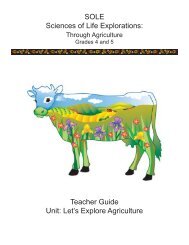Insect Anatomy - Agriculture in the Classroom
Insect Anatomy - Agriculture in the Classroom
Insect Anatomy - Agriculture in the Classroom
You also want an ePaper? Increase the reach of your titles
YUMPU automatically turns print PDFs into web optimized ePapers that Google loves.
TERMS<br />
These terms are highlighted <strong>in</strong> bold throughout <strong>the</strong> lesson pages.<br />
abdomen - <strong>the</strong> last segment of an <strong>in</strong>sect’s body; it conta<strong>in</strong>s organs that are important to<br />
digestion<br />
amateur - a person who does someth<strong>in</strong>g just for pleasure, but does not get paid for it<br />
anatomy - <strong>the</strong> structure of an animal or plant<br />
antennae - a pair of flexible feelers on <strong>the</strong> head of an <strong>in</strong>sect used to sense <strong>the</strong> environment<br />
arthropod - a group of animals that has a three-part body, jo<strong>in</strong>ted legs, no skeleton, and a hard<br />
outer cover<strong>in</strong>g<br />
bug - an <strong>in</strong>sect with thickened w<strong>in</strong>gs and mouthparts used for pierc<strong>in</strong>g and suck<strong>in</strong>g<br />
compound eye - <strong>the</strong> type of eye of most <strong>in</strong>sects, made up of many smaller parts that are each<br />
able to see part of <strong>the</strong> image.<br />
entomologist - a scientist who studies <strong>in</strong>sects<br />
exoskeleton - a hard cover<strong>in</strong>g on <strong>the</strong> outside of organisms such as <strong>in</strong>sects, that provides structural<br />
support and protection<br />
<strong>in</strong>sect - an arthropod with three body segments (head, thorax and abdomen) and three<br />
pairs of jo<strong>in</strong>ted legs<br />
mammals - warm-blooded animals with skeletons; <strong>the</strong>ir sk<strong>in</strong> is covered with hair or fur and <strong>the</strong>y<br />
produce milk to feed <strong>the</strong>ir young<br />
molt - to shed an outer cover<strong>in</strong>g that is replaced by a new one; birds molt fea<strong>the</strong>rs, snakes<br />
molt sk<strong>in</strong>s, and <strong>in</strong>sects molt exoskeletons<br />
mouthparts - <strong>the</strong> parts of an <strong>in</strong>sect’s mouth especially adapted for a specific way of feed<strong>in</strong>g<br />
muscle - a body tissue made of fibers that is able to relax or contract; shorten<strong>in</strong>g and leng<strong>the</strong>n<strong>in</strong>g<br />
muscles causes parts of <strong>the</strong> body to move<br />
nectar - a sweet liquid made by plants, which attracts and feeds various <strong>in</strong>sects.<br />
passive - someth<strong>in</strong>g that does not act on its own, but only when someth<strong>in</strong>g else acts on it.<br />
pollen - a f<strong>in</strong>e powder produced by plants for reproduction<br />
symmetry - sameness on both sides of a divid<strong>in</strong>g l<strong>in</strong>e<br />
thorax - <strong>the</strong> middle body segment of an <strong>in</strong>sect between <strong>the</strong> head and <strong>the</strong> abdomen.<br />
ultraviolet - a color of light that humans can’t see but some animals can<br />
Integrated Pest Management is a specialized form of environmental management where<strong>in</strong><br />
scientific research and real world application work toge<strong>the</strong>r to reduce pests such as <strong>in</strong>sects,<br />
diseases or weeds.<br />
1. Properly identify pests 4. Determ<strong>in</strong>e an action threshold<br />
2. Learn <strong>the</strong> pest/ host biology 5. Choose <strong>the</strong> best tactic<br />
3. Sample <strong>the</strong> environment for pests 6. Evaluate results<br />
SAFETY<br />
General classroom safety practices should be followed. Use caution when handl<strong>in</strong>g <strong>in</strong>sects.
















